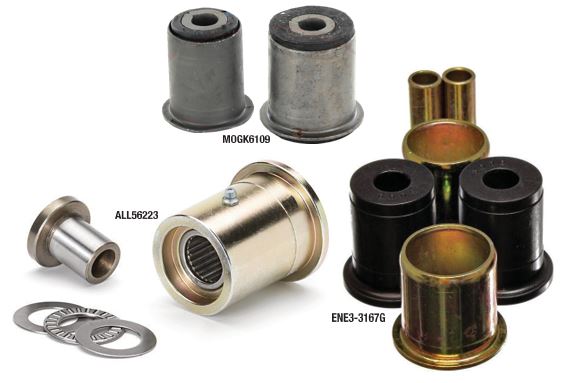Control arm bushings are not only highly stressed suspension components but also play a critical role in a car’s handling, regardless of whether they’re fitted to the family mini-van, performance street machine, or a pure-bred race car. Their function is to absorb shock, vibration and road noise, theoretically isolating the suspension from the passenger’s compartment.
They must also allow the control arms to move smoothly throughout the entire range of suspension travel without deflection. Poor handling and sudden changes in alignment are common symptoms of deflection, often caused by a bushing that has deteriorated. It is not uncommon for worn bushings to cause sudden changes in camber, caster, or toe, particularly if the vehicle in question is traveling down a rough, bumpy road or race track surface.
Most OEM-style bushings are constructed from rubber, which offers a long life when used on traditional passenger cars. Manufacturers use a wide range of formulations in durometer, a measure of a bushing’s hardness, to meet specific component demands. The softer the durometer, the more capable the bushing is of reducing vibration and road noise, with the compromise that it is more prone to deflection.
On the other hand, a harder durometer bushing will deliver improved handling and reduced deflection, but with the trade-off of increased road noise and vibration. When stock, OEM-type rubber bushings are desired to maintain a quiet, comfortable ride, Moog Chassis Parts offers a wide selection for the passenger car market.

Rubber is an effective material in the construction of control arm bushings for passenger cars, however, it does have several drawbacks. It is adversely affected by the environment, particularly when exposed to lubricants, heat, or road salt. Lubricants are particularly harmful to the life of a rubber bushing. If a bushing is exposed to a nearby transmission fluid leak, for example, the fluid can quickly absorb into the bushing, softening it and destroying its integrity. Road salt or heat from a nearby exhaust or header pipe can cause the bushings to harden and crack. Once the bushing deteriorates from any of the previously mentioned causes, it can become subject to increased deflection.
High-performance polyurethane control arm bushings are a popular alternative for high-performance and racing applications. Offered by manufacturers including Energy Suspension, polyurethane bushings are much more durable than rubber and are unaffected by chemicals, road salt, or lubricants. They also have a harder durometer rating, resulting in reduced deflection and improved handling. Max Manning of Energy Suspension notes that “polyurethane bushings are much more durable than rubber.”
“We’ve had customers that have used our product continually for over 20 years without any issues,” states Manning. Energy Suspension custom tailors bushing durometer to meet the demands of the specific application, according to Manning, and has a wide variety of formulations to choose from.
Another option for high-performance street or racing applications are aluminum control arm bushings with Delrin inserts, offered by Global West Suspension. A synthetic polymer that is rigid and virtually friction free, Delrin bushings have become particularly popular on drag racing applications.
While not suitable for street operation, steel control arm bushings may be used for racing applications. Traditional steel bushings feature a two-piece design and many include zerk fittings to allow lubrication. Steel bushings are also available from a variety of suppliers fitted with either nylon inserts, monoball bearings, or needle thrust bearings. Allstar Performance offers bushings fitted with needle bearings for the ultimate in smooth, quick suspension response. These special bushings are extremely effective in providing greatly improved handling and enhanced durability. Regardless of design, all steel bushings must be greased periodically to maintain maximum effectiveness.
When choosing bushings for racing, be sure to check sanctioning body rules. For example, the Allstar Performance bushings with needle bearings are not IMCA legal. Allstar offers nylon inserts that may be substituted for the needle bearings in order to meet IMCA rules Bushing replacement may be accomplished by first removing the control arm from the vehicle.
Follow by cleaning and lubricating the installation area as the bushing may be removed using one of two methods. The most popular method involves using a specialized bushing installation/ removal tool to press the bushing out of the control arm. OEM-style bushings may also be removed by heating the bushing shell with a propane torch until the rubber insert melts, allowing the bushing shell to then be collapsed and driven out with a hammer. After cleaning and lubrication of the installation area, the new bushing may then be pressed in using an installation tool.
Once the bushings have been replaced and the control arm is ready to be re-installed, steel bushings that lack zerk fittings may be secured to the chassis using specially bolts with grease channels, if desired, such as those offered by Howe Racing Enterprises. Available for popular GM and Ford applications, the bolts include an internal grease channel and zerk fitting that allows periodic lubrication.
When re-installing control arms fitted with rubber bushings, it is important that the control arm bolts aren’t torqued until the suspension is fully loaded. Tightening the bolts while the vehicle is on a shop hoist, for example, will cause the bushings to bind once the suspension is loaded, potentially damaging them and shortening their life expectancy.
Taking care in selecting the proper control arm bushings will not only aid the car’s handling characteristics, but also provide smooth suspension response without any bind or deflection for many years to come.